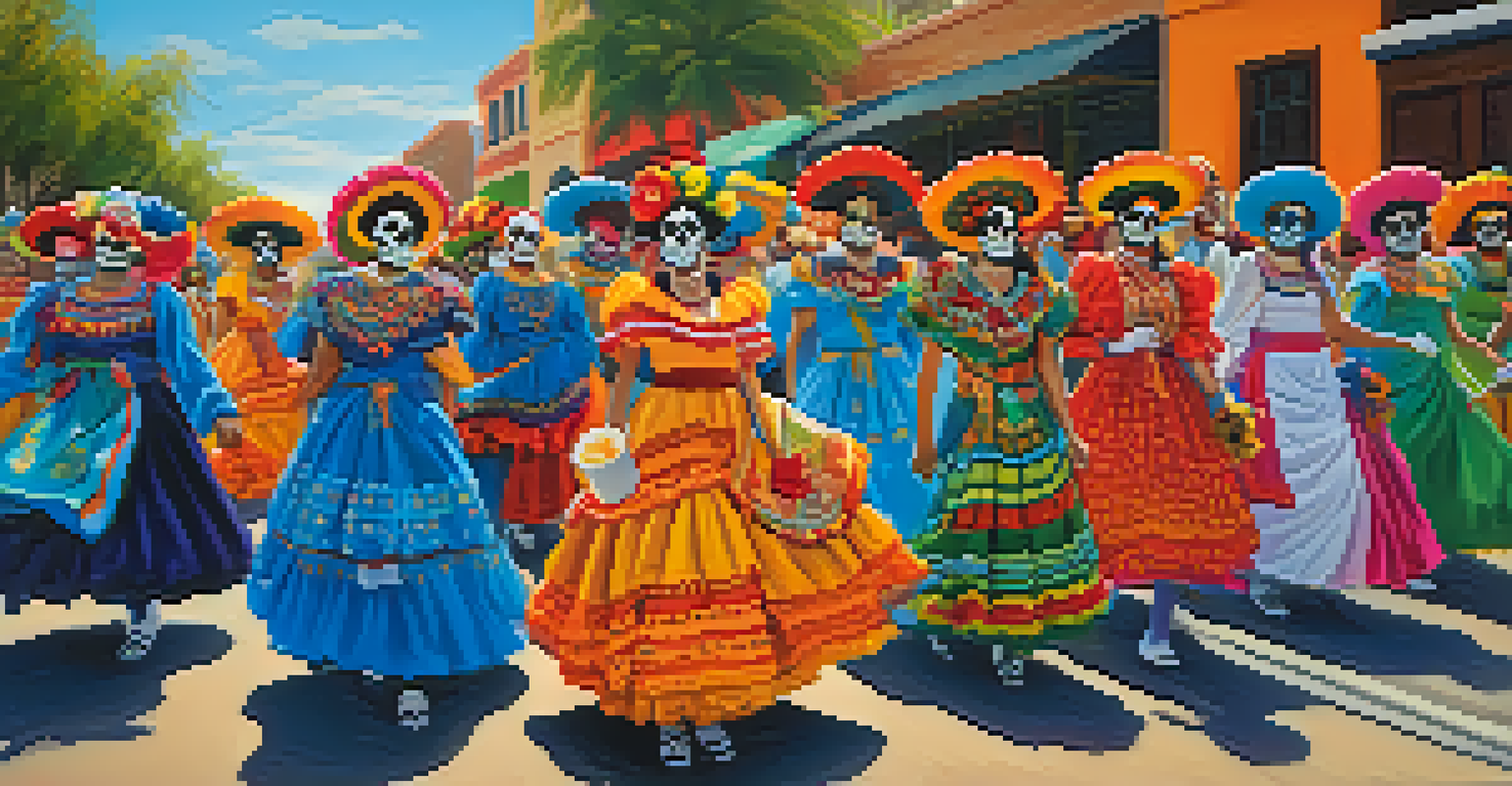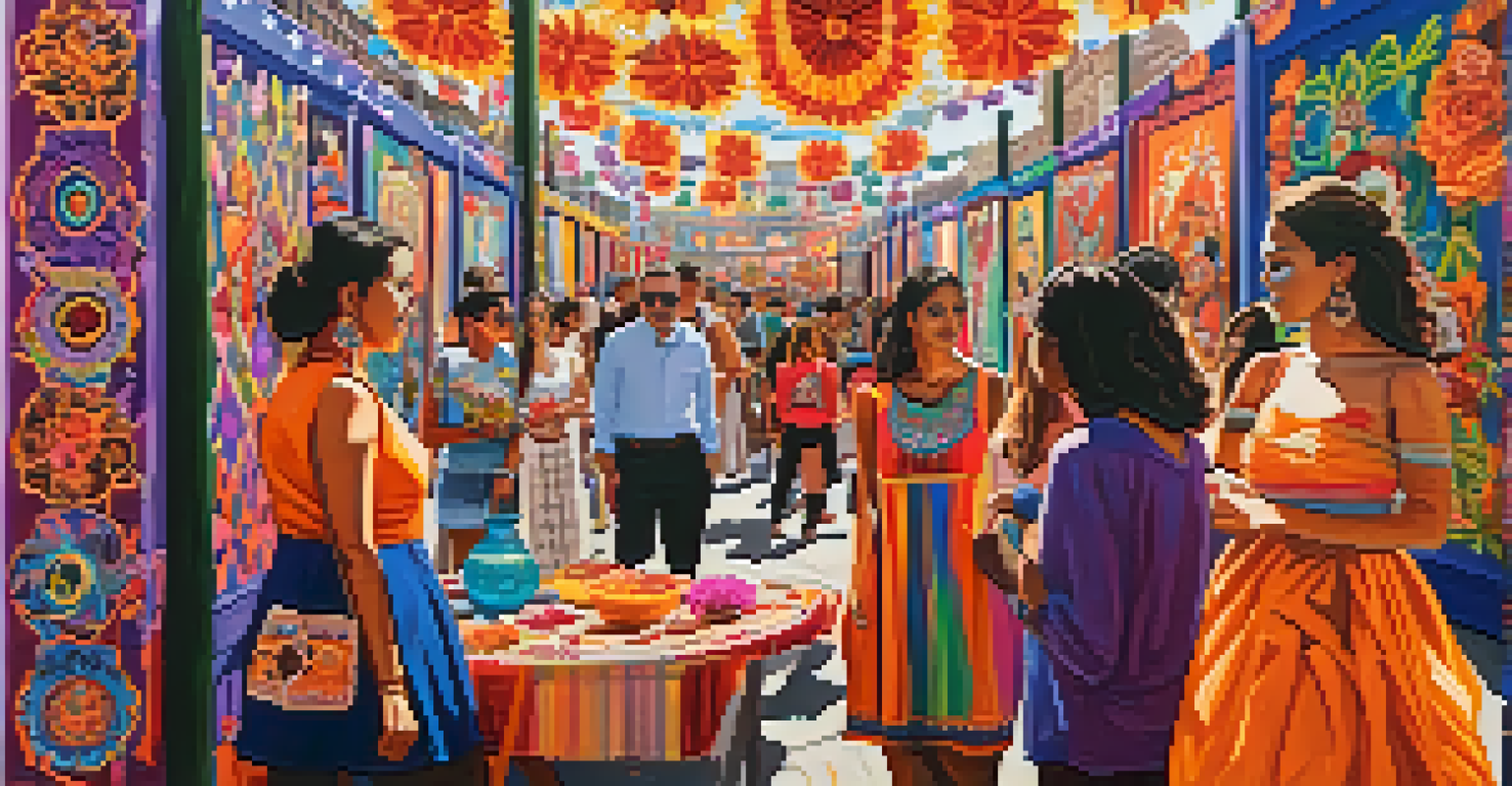The Rich Heritage of Carlsbad's Dia de los Muertos Festival

Understanding Dia de los Muertos: A Cultural Overview
Dia de los Muertos, or Day of the Dead, is a Mexican tradition celebrating the lives of deceased loved ones. This colorful holiday, typically observed on November 1st and 2nd, combines indigenous customs with Spanish influences, creating a unique cultural tapestry. In Carlsbad, this celebration has grown into a vibrant festival that honors both the past and present.
To live in hearts we leave behind is not to die.
At its core, Dia de los Muertos invites people to remember and celebrate their ancestors, transforming grief into remembrance. Families build altars, known as 'ofrendas,' adorned with photographs, candles, and favorite foods of the departed. This not only highlights the bond between the living and the dead but also reflects the joyfulness inherent in the celebration.
The festival serves as a reminder that death is a part of life, encouraging participants to embrace the memories of those who have passed. In Carlsbad, this annual event has become a community gathering, fostering a deeper understanding of Mexican culture and traditions while inviting all to partake in the festivities.
The Origins of Carlsbad's Celebration
Carlsbad’s Dia de los Muertos Festival traces its roots back to the local Mexican community celebrating their heritage. In the early years, the event was a modest gathering, but it has since evolved into a large-scale festival, drawing people from surrounding areas. This growth reflects a rising interest in cultural exchange and a desire for community connection.

The festival's inception in Carlsbad can be attributed to dedicated individuals and organizations aiming to preserve and share Mexican traditions. Their efforts have not only kept these customs alive but have also educated a diverse audience about the significance of the holiday. This inclusivity is a vital aspect of the festival, bridging gaps between cultures.
Celebration of Life and Death
Dia de los Muertos transforms grief into remembrance, allowing families to honor their ancestors through vibrant festivities.
Through workshops, art displays, and performances, the festival showcases the rich traditions associated with Dia de los Muertos. The event has become a platform for artists and community members to express their creativity, ensuring the celebration remains relevant and engaging for future generations.
Festive Activities and Traditions During the Festival
Carlsbad's Dia de los Muertos Festival is a feast for the senses, filled with colorful decorations, traditional music, and delicious food. Visitors can expect to see beautifully crafted altars adorned with marigolds, papel picado (perforated paper), and sugar skulls, each element holding special significance. These displays invite attendees to reflect on the lives of those being honored.
Death leaves a heartache no one can heal, love leaves a memory no one can steal.
One of the highlights of the festival is the vibrant procession that winds through the streets, featuring participants dressed in traditional attire, including decorated skull masks and colorful dresses. This lively parade not only serves as a tribute to the deceased but also celebrates the living, creating a sense of unity among all participants. It’s a sight that brings together friends, families, and even strangers.
In addition to the visual spectacle, the festival offers workshops where attendees can learn about traditional crafts, such as sugar skull decorating and flower arranging. These hands-on experiences allow people to engage with the culture and create lasting memories. The combination of art, music, and food makes for an unforgettable experience that captures the spirit of Dia de los Muertos.
Significance of Altars: Ofrendas Explained
The ofrenda, or altar, is the centerpiece of Dia de los Muertos celebrations, reflecting the personal touches families add to honor their loved ones. Each altar is a unique expression, often including photographs, mementos, and favorite foods that belonged to the deceased. These offerings symbolize the bond between the living and the dead, allowing the spirits to feel welcomed during the festivities.
Building an ofrenda is a deeply personal ritual for families, where they carefully choose items that resonate with their loved ones' lives. This process often involves storytelling, where family members share memories and anecdotes about those being honored. Through this shared experience, the act of creating the altar becomes a beautiful way to keep the memories alive.
Community and Cultural Exchange
Carlsbad's festival fosters a sense of belonging by bringing together diverse individuals to celebrate and learn about Mexican traditions.
In Carlsbad, visitors can admire numerous ofrendas displayed throughout the festival, each telling a different story. This variety illustrates the diversity within the community, as families from different backgrounds contribute their interpretations of the tradition. The ofrendas are more than mere decorations; they are heartfelt tributes that celebrate life and legacy.
Culinary Delights: Food Traditions at the Festival
Food is an integral part of Dia de los Muertos, with many traditional dishes served during the festival. Sweet treats like pan de muerto—a special bread shaped like a skull—are commonly enjoyed, symbolizing the cycle of life and death. The aroma of freshly prepared meals fills the air, creating an inviting atmosphere for festival-goers.
In Carlsbad, local vendors showcase a variety of authentic Mexican dishes, from tamales to mole, allowing participants to indulge in the flavors of the culture. This culinary experience not only satisfies the palate but also serves as a reminder of the importance of food in bringing people together. Sharing a meal is a way to celebrate life and honor those who have passed.
As families gather around their ofrendas, the food becomes a focal point of remembrance, connecting generations through shared recipes and flavors. The act of preparing and enjoying these traditional dishes is a way to keep cultural heritage alive. Each bite taken during the festival is a celebration of history, love, and community.
Artistic Expressions: The Role of Art in the Festival
Art plays a vital role in Carlsbad's Dia de los Muertos Festival, with numerous artists contributing their talents to bring the celebration to life. From intricate face painting that transforms participants into calacas (skeletons) to stunning murals depicting scenes from Mexican folklore, creativity is on full display. This artistic expression enhances the festive atmosphere and engages attendees of all ages.
The festival also features art installations that reflect the themes of remembrance and celebration. Many local artists create pieces specifically for the event, highlighting the significance of Dia de los Muertos in the community. These installations serve as a visual tribute, encouraging reflection and discussion about life, death, and cultural heritage.
Art and Creativity Shine
The festival showcases artistic expressions that enhance the celebration, allowing attendees to engage with traditional crafts and cultural heritage.
Through workshops and demonstrations, attendees have the opportunity to learn about traditional art forms, such as papel picado and sugar skull painting. These activities not only foster creativity but also educate participants about the history and meaning behind these crafts. The artistic dimension of the festival enriches the overall experience, making it a celebration of both life and art.
Community Spirit: Bringing People Together
At its heart, Carlsbad's Dia de los Muertos Festival embodies the spirit of community. It brings together people from diverse backgrounds, fostering a sense of belonging and shared experience. The festival serves as a platform for cultural exchange, allowing individuals to learn about and appreciate the traditions of others.
During the event, attendees often share stories, laughter, and even tears as they remember their loved ones. This collective experience strengthens bonds within the community, creating a supportive environment that encourages open dialogue about life and loss. The festival is a powerful reminder of how cultural traditions can unite people.

As the festival continues to grow, it remains committed to inclusivity and celebration. Local organizations and volunteers work tirelessly to ensure that everyone feels welcome, regardless of their background. The sense of togetherness fostered during the festival leaves a lasting impact, encouraging ongoing connections beyond the event itself.